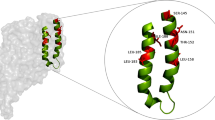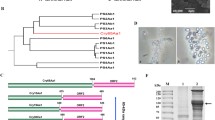Abstract
It was reported that the highly conserved C-terminal region of Bacillus thuringiensis Cry1A protoxins was very important for parasporal crystal formation and solubility feature in alkaline environment. In order to improve the solubilization efficiency of Cry2Aa crystal, the coding sequences of Cry2Aa protein and the C-terminal half of Cry1Ac were fused seamlessly through Red/ET homologous recombination and expressed in an acrystalliferous B. thuringiensis strain under the control of the cry1Ac promoter and terminator. Microscopic observation revealed that the recombinant strain containing the chimeric gene cry2Aa-1Ac produced distinct parasporal inclusion with semispherical to approximately cuboidal shape during sporulation. SDS-PAGE analysis showed that this strain expressed stable 130-kDa Cry2Aa-1Ac chimeric protein, which was confirmed to be the correctly expressed product by LC-MS/MS. The chimeric protein inclusion could be effectively dissolved at pH 10.5 and activated by trypsin like the parental Cry1Ac crystal. While, the parental Cry2Aa crystal exhibited very low solubility under this condition. Bioassays against third-instar larvae of Helicoverpa armigera proved that the chimeric protein was more toxic than Cry2Aa. Additionally, synergistic effect was clearly detected between the chimeric protein and Cry1Ac against H. armigera, while there was only additive effect for the combination of wild Cry2Aa and Cry1Ac. These results indicated that the developed chimeric protein might serve as a potent insecticidal toxin used in the field against lepidopteran pests.




Similar content being viewed by others
References
Agaisse H, Lereclus D (1995) How does Bacillus thuringiensis produce so much insecticidal crystal protein? J Bacteriol 177:6027–6032
Arantes O, Lereclus D (1991) Construction of cloning vectors for Bacillus thuringiensis. Gene 108:115–119
Bian X, Huang F, Stewart FA, Xia L, Zhang Y, Müller R (2012) Direct cloning, genetic engineering, and heterologous expression of the syringolin biosynthetic gene cluster in E. coli through red/ET recombineering. Chembiochem 13:1946–1952
Carmona AA, Ibarra JE (1999) Expression and crystallization of a Cry3Aa-Cry1Ac chimerical protein of Bacillus thuringiensis. World J Microbiol Biotechnol 15:455–463
Du C, Martin PA, Nickerson KW (1994) Comparison of disulfide contents and solubility at alkaline pH of insecticidal and noninsecticidal Bacillus thuringiensis protein crystals. Appl Environ Microbiol 60:3847–3853
Elleuch J, Zghal RZ, Jemaà M, Azzouz H, Tounsi S, Jaoua S (2014) New Bacillus thuringiensis toxin combinations for biological control of lepidopteran larvae. Int J Biol Macromol 65:148–154
Elleuch J, Zghal RZ, Ben Fguira I, Lacroix MN, Suissi J, Chandre F, Tounsi S, Jaoua S (2015) Effects of the P20 protein from Bacillus thuringiensis israelensis on insecticidal crystal protein Cry4Ba. Int J Biol Macromol 79:174–179
Fu J, Bian X, Hu S, Wang H, Huang F, Seibert PM, Plaza A, Xia L, Müller R, Stewart AF, Zhang Y (2012) Full-length RecE enhances linear-linear homologous recombination and facilitates direct cloning for bioprospecting. Nat Biotechnol 30:440–446
Ghosh G, Ganguly S, Purohit A, Chaudhuri RK, Das S, Chakraborti D (2017) Transgenic pigeonpea events expressing Cry1Ac and Cry2Aa exhibit resistance to Helicoverpa armigera. Plant Cell Rep 36:1037–1051
Li H, Bouwer G (2014) Evaluation of the synergistic activities of Bacillus thuringiensis Cry proteins against Helicoverpa armigera (Lepidoptera: Noctuidae). J Invertebr Pathol 121:7–13
Lu K, Gu Y, Liu X, Lin Y, Yu XQ (2017) Possible insecticidal mechanisms mediated by immune-response-related Cry-binding proteins in the midgut juice of Plutella xylostella and Spodoptera exigua. J Agric Food Chem 65:2048–2055
Naimov S, Martens-Uzunova E, Weemen-Hendriks M, Dukiandjiev S, Minkov I, de Maagd RA (2006) Carboxy-terminal extension effects on crystal formation and insecticidal properties of Colorado potato beetle-active Bacillus thuringiensis δ-endotoxins. Mol Biotechnol 32:185–196
Pardo-López L, Muñoz-Garay C, Porta H, Rodríguez-Almazán C, Soberón M, Bravo A (2009) Strategies to improve the insecticidal activity of cry toxins from Bacillus thuringiensis. Peptides 30:589–595
Pardo-López L, Soberón M, Bravo A (2013) Bacillus thuringiensis insecticidal three-domain cry toxins: mode of action, insect resistance and consequences for crop protection. FEMS Microbiol Rev 37:3–22
Park HW, Ge B, Bauer LS, Federici BA (1998) Optimization of Cry3A yields in Bacillus thuringiensis by use of sporulation-dependent promoters in combination with the STAB-SD mRNA sequence. Appl Environ Microbiol 64:3932–3938
Park HW, Hice RH, Federici BA (2016) Effect of promoters and plasmid copy number on Cyt1A synthesis and crystal assembly in Bacillus thuringiensis. Curr Microbiol 72:33–40
Peña-Cardeña A, Grande R, Sánchez J, Tabashnik BE, Bravo A, Soberón M, Gómez I (2018) The C-terminal protoxin domain of Bacillus thuringiensis Cry1Ab toxin has a functional role in binding to GPI-anchored receptors in the insect midgut. J Biol Chem 293:20263–20272
Peng D, Wang F, Li N, Zhang Z, Song R, Zhu Z, Ruan L, Sun M (2011) Single cysteine substitution in Bacillus thuringiensis Cry7Ba1 improves the crystal solubility and produces toxicity to Plutella xylostella larvae. Environ Microbiol 13:2820–2831
Rajagopal R, Arora N, Sivakumar S, Rao NG, Nimbalkar SA, Bhatnagar RK (2009) Resistance of Helicoverpa armigera to Cry1Ac toxin from Bacillus thuringiensis is due to improper processing of the protoxin. Biochem J 419:309–316
Sanahuja G, Banakar R, Twyman RM, Capell T, Christou P (2011) Bacillus thuringiensis: a century of research, development and commercial applications. Plant Biotechnol J 9:283–300
Schnepf E, Crickmore N, Van Rie J, Lereclus D, Baum J, Feitelson J, Zeigler DR, Dean DH (1998) Bacillus thuringiensis and its pesticidal crystal proteins. Microbiol Mol Biol Rev 62:775–806
Shah JV, Yadav R, Ingle SS (2017) Engineered Cry1Ac-Cry9Aa hybrid Bacillus thuringiensis delta-endotoxin with improved insecticidal activity against Helicoverpa armigera. Arch Microbiol 199:1069–1075
Sramala I, Uawithya P, Chanama U, Leetachewa S, Krittanai C, Katzenmeier G, Panyim S, Angsuthanasombat C (2000) Single proline substitutions of selected helices of the Bacillus thuringiensis Cry4B toxin affect inclusion solubility and larvicidal activity. J Biochem Mol Biol Biophys 4:187–193
Sun Y, Fu Z, Ding X, Xia L (2008) Evaluating the insecticidal genes and their expressed products in Bacillus thuringiensis strains by combining PCR with mass spectrometry. Appl Environ Microbiol 74:6811–6813
Tabashnik BE (1992) Evaluation of synergism among Bacillus thuringiensis toxins. Appl Environ Microbiol 58:3343–3346
Tabashnik BE, Zhang M, Fabrick JA, Wu Y, Gao M, Huang F, Wei J, Zhang J, Yelich A, Unnithan GC, Bravo A, Soberón M, Carrière Y, Li X (2015) Dual mode of action of Bt proteins: protoxin efficacy against resistant insects. Sci Rep 5:15107
Wang F, Liu Y, Zhang F, Chai L, Ruan L, Peng D, Sun M (2012) Improvement of crystal solubility and increasing toxicity against Caenorhabditis elegans by asparagine substitution in block 3 of Bacillus thuringiensis crystal protein Cry5Ba. Appl Environ Microbiol 78:7197–7204
Widner WR, Whiteley HR (1989) Two highly related insecticidal crystal proteins of Bacillus thuringiensis subsp. kurstaki possess different host range specificities. J Bacteriol 171:965–974
Wu KM, Lu YH, Feng HQ, Jiang YY, Zhao JZ (2008) Suppression of cotton bollworm in multiple crops in China in areas with Bt toxin-containing cotton. Science 321:1676–1678
Yin J, Ding X, Xia L, Yu Z, Lv Y, Hu S, Huang S, Cao Z, Xiao X (2011) Transcription of gene in an acrystalliferous strain of Bacillus thuringiensis XBU001 positively regulated by the metalloprotease camelysin gene at the onset of stationary phase. FEMS Microbiol Lett 318:92–100
Zghal RZ, Elleuch J, Ben Ali M, Darriet F, Rebaï A, Chandre F, Jaoua S, Tounsi S (2017) Towards novel cry toxins with enhanced toxicity/broader: a new chimeric Cry4Ba/Cry1Ac toxin. Appl Microbiol Biotechnol 101:113–122
Zhang Y, Muyrers JP, Testa G, Stewart AF (2000) DNA cloning by homologous recombination in Escherichia coli. Nat Biotechnol 18:1314–1317
Zhang H, Wu S, Yang Y, Tabashnik BE, Wu Y (2012) Non-recessive Bt toxin resistance conferred by an intracellular cadherin mutation in field-selected populations of cotton bollworm. PLoS One 7:e53418
Zheng A, Zhu J, Tan F, Guan P, Yu X, Wang S, Deng Q, Li S, Liu H, Li P (2010) Characterisation and expression of a novel haplotype cry2A-type gene from Bacillus thuringiensis strain JF19-2. Ann Microbiol 60:129–134
Funding
This work was supported by the National Key Research and Development Program (2017YFD0201201), Key Research and Development Program of Hunan Province (2015NK3032), the Training Program of Young Key Teachers in Universities of Hunan Province, Graduate Teaching Reform Program of Hunan Normal University (12JG14), and the Cooperative Innovation Center of Engineering and New Products for Developmental Biology of Hunan Province (20134486), P. R. China.
Author information
Authors and Affiliations
Contributions
XFQ and YJS designed the study and wrote the manuscript. XQL, XMR, RL, and BBW participated in the experiments. SSY, LLQ, and XTM contributed to the figures and tables. XZD and LQX analyzed the mass spectrometric data. All authors have read and approved the final manuscript.
Corresponding author
Ethics declarations
Conflict of interest
The authors declare that they have no conflict of interest.
Ethical statement
This research does not contain any studies with human participants or animals.
Additional information
Publisher’s note
Springer Nature remains neutral with regard to jurisdictional claims in published maps and institutional affiliations.
Rights and permissions
About this article
Cite this article
Qiu, X., Lu, X., Ren, X. et al. Solubility enhancement of Cry2Aa crystal through carboxy-terminal extension and synergism between the chimeric protein and Cry1Ac. Appl Microbiol Biotechnol 103, 2243–2250 (2019). https://doi.org/10.1007/s00253-018-09606-w
Received:
Revised:
Accepted:
Published:
Issue Date:
DOI: https://doi.org/10.1007/s00253-018-09606-w




